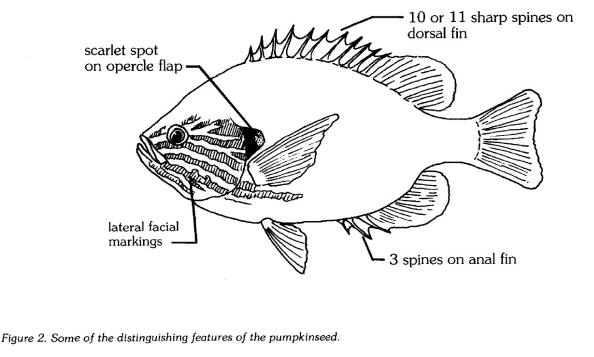Adaption
Appearance:
Pumpkinseed sunfish a wide variety of defining features. For example, as shown in Figure 2 photo below, there is a deep scarlet spot right behind the face of the fish on the opercle flap. They are typically orange or red-orange on their breast and underside, while their sides are brown to olive in color. Throughout the body there are specks of many colors including orange, yellow, blue, and green. These spots can be found on the back, the sides and on the anal and caudal fins. There are also stripes on this species. Usually there are about seven to eight vertical bands across the sides of the body (Holtan 1998). There are a few differences between males and females due to sexual dimorphism. Their colors are usually very bright, however, the males are typically brighter, especially during mating season. Although the females are less vibrantly colored, they have more visible vertical lines. These lines are helpful for camouflage, as they resemble the way light from the sun would reflect on the water. The Pumpkinseed fish is very small in size and length. It has a narrow body and is typically under 20 centimeters in length from tip to fin.
Protection:
Because the Pumpkinseed is such a small fish, it has a few protective features on its body. The most prominent is the sharp spines found on its dorsal and anal fins. This fish typically has 10-11 spines and 10-12 rays following the spines on the dorsal fins. The anal fin typically has 2-3 spines followed by 10-11 rays (Holtan 1998). This fish has another interesting characteristic for protection: a lateral line system. This allows the fish to feel changes in the movement of the water using a variety of mechanical receptors. The bright scarlet coloring on the opercle flap mentioned before is intended to threaten away predators or competition by intimidation.
